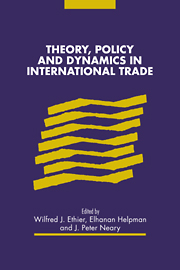Book contents
- Frontmatter
- Contents
- List of conference participants
- I Introduction
- II History, geography and the theory of trade
- III The structure of simple trade models
- IV Policy towards international trade
- V Trade, growth and dynamics
- 11 Prices of goods and factors in a dynamic stochastic economy
- 12 Capital market imperfections and the infant industry argument for protection
- 13 Endogenous real business cycles and international Specialization
- 14 Impact of government on growth and trade
- 15 Long-run production frontiers for the Jones specific-factors model with optimal capital accumulation
- 16 Hysteresis in the trade pattern
- Index
11 - Prices of goods and factors in a dynamic stochastic economy
Published online by Cambridge University Press: 16 March 2010
- Frontmatter
- Contents
- List of conference participants
- I Introduction
- II History, geography and the theory of trade
- III The structure of simple trade models
- IV Policy towards international trade
- V Trade, growth and dynamics
- 11 Prices of goods and factors in a dynamic stochastic economy
- 12 Capital market imperfections and the infant industry argument for protection
- 13 Endogenous real business cycles and international Specialization
- 14 Impact of government on growth and trade
- 15 Long-run production frontiers for the Jones specific-factors model with optimal capital accumulation
- 16 Hysteresis in the trade pattern
- Index
Summary
Introduction
Of all the important contributions Ron Jones has made to international trade theory, probably the most outstanding is his analysis of the equilibrium effects of changes in the prices of tradable goods on the returns to non-tradeable factors. In Jones (1965), he elucidated the Stolper–Samuelson magnification effect in the Heckscher–Ohlin model. In the process, Jones replaced earlier intricate geometric techniques with the delightfully simple and elegant λ–θ algebra. Jones (1971), together with Samuelson (1971), gave us a general equilibrium formulation of the Ricardo–Viner model, where the relationship between the prices of goods and factors is different from, and perhaps more realistic than, that of the Heckscher–Ohlin model. Jones (1977) and Jones and Scheinkman (1977) were insightful studies of whether and how such relationships extend to models with more goods and factors.
The progress of trade theory in the last two decades has led to formal models of uncertainty and adjustment in a trading economy. Jones' birthday celebration seems a particularly suitable occasion for developing this line of research to examine the relationship between the prices of goods and factors in a dynamic economy with uncertainty.
Comparative statics has been the basic technique for analyzing the effect of changes in the prices of tradeable goods on the returns to non-tradable factors. Goods' prices are exogenous parameters in specifying the general equilibrium of a small open economy. When such exogenous parameters change, the whole equilibrium shifts. Total differentiation, or some other comparative static argument such as revealed preference, allows us to determine the resulting changes in the endogenous variables, including the factor prices.
- Type
- Chapter
- Information
- Theory, Policy and Dynamics in International Trade , pp. 175 - 190Publisher: Cambridge University PressPrint publication year: 1993

